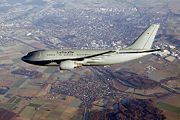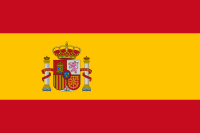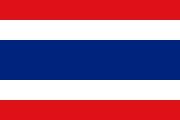Airbus A310
| Airbus A310 | |
|---|---|
 |
|
|
|
|
| Role | Airliner |
| Manufacturer | Airbus |
| First flight | 3 April 1982 |
| Introduced | April 1983 |
| Primary users | FedEx Express Air India Air Transat Pakistan International |
| Produced | 1983-2007 |
| Number built | 255 |
| Developed from | Airbus A300 |
| Variants | A310 MRTT CC-150 Polaris |
The Airbus A310 is a medium to long-range widebody airliner. Launched in 1978, it was the second aircraft created by the Airbus consortium of European aerospace companies, which is now fully owned by EADS. The A310 is a shortened derivative of the A300, the first twin-engined widebody airliner. The A310 (along with the A300) officially ceased production in July 2007 although the last delivery was in June 1998.
Contents |
History
The A310's range exceeds that of all the A300 models, except for the A300-600, which surpasses the A310-200. This feature has led to the aircraft being used extensively on transatlantic routes. The A300 and A310 introduced the concept of commonality: A300-600 and A310 pilots can qualify for the other aircraft with one day of training.
Like its sister aircraft, the A300, the A310 has reached the end of its market life as a passenger and cargo aircraft. There have been no new A310 passenger orders since the late 1990s, and only a few freighter orders remain. The A310 (along with the A300) ceased production in July 2007, though five orders from Iraqi Airways remained on the books until July 2008. The remaining freighter sales are to be fulfilled by the new A330-200F derivative.[1]
The aircraft was formally launched in July 1978 for Lufthansa and Swissair. A further development of the A300, the aircraft was initially designated the A300 B10. Essentially a "baby" A300, the main differences in the two aircraft are
- Shortened fuselage - same cross section, providing capacity of about 200.
- Redesigned rear fuselage - altered tapering and moving aft of the rear bulkhead created additional capacity. The redesign was also used for the A300-600 and A330/A340 fuselages.
- Redesigned wing - designed by British Aerospace who rejoined Airbus consortium
- Smaller vertical fin
The A310 was marketed as an introduction to widebody operations for developing airlines. The A310 was replaced in Airbus' lineup by the highly successful A330-200, which shares its fuselage cross-section. Between 1983 and the very last aircraft produced 1998, 255 A310s were delivered by Airbus.
The A300 and A310 established Airbus as a competitor to Boeing and allowed it to go ahead with the more ambitious A320 and A330/A340 families.
Variants



A310-200
The first A310, the 162nd Airbus off the production line, made its maiden flight in April 1982 powered by Pratt & Whitney JT9D engines. The -200 entered service with Swissair and Lufthansa a year later. Also the late series -200 also featured winglets just like the -300.
A310-200C A convertible version, the seats can be removed and cargo placed on the main deck.
A310-300
First flown in July 1985, the -300 has an increased MTOW and an increase in range, provided by additional centre and horizontal stabilizer (trim-tank) fuel tanks. This model also introduced wingtip fences to improve aerodynamic efficiency, a feature that has since been retrofitted to some -200s. The aircraft entered service in 1986, again with Swissair. No production freighters of the A310 were produced. Operators such as FedEx instead adapt ex-airline A310s into freighters. Most have been the -300 version.
- A310-300C
A convertible passenger/cargo version, the seats can be removed and cargo placed on the main deck.
- A310-300F
An all-cargo version.
A310 MRTT

A310 MRTT:The A310 has been operated by many of the world's airforces as a pure transport, however some are now being converted to the "Multi Role Tanker Transport" configuration by EADS, providing an aerial refueling capability. Six have been ordered; four by the German Luftwaffe and two by the Canadian Forces. Deliveries began in 2004. Three are being converted at EADS' Elbe Flugzeugwerke (EFW) in Dresden, Germany; the other three at Lufthansa Technik in Hamburg, Germany. The Chilean Air Force has recently purchased two second-hand A310s to replace its ageing 707-320 'Aguila' tanker and transports. The first was received in October 2007.
Operators
Military operators
The A310 has been used by the armed forces of the following countries:
 Belgium - Belgian Air Component
Belgium - Belgian Air Component Canada - Canadian Forces Air Command - designated CC-150 Polaris
Canada - Canadian Forces Air Command - designated CC-150 Polaris France - French Air Force
France - French Air Force Germany - German Air Force
Germany - German Air Force Spain - Spanish Air Force
Spain - Spanish Air Force Thailand - Royal Thai Air Force
Thailand - Royal Thai Air Force Pakistan - Pakistan Air Force
Pakistan - Pakistan Air Force
Accident and incidents
- Hull-loss Accidents: 7 with a total of 548 fatalities
- Hijackings: 10 with a total of 5 fatalities
- S7 Airlines Flight 778, an Airbus A310-324 jet from Moscow carrying 196 passengers and eight crew, overshot the runway at Irkutsk in Siberia, plowed through a concrete barrier and caught fire as it crashed into buildings. Reports said that 70 of the 204 on board survived, with 12 still missing.[2] Since the accident, casualty figures have fluctuated, in part due to three people boarding the aircraft that were not on the passenger manifest, and some survivors having walked home and assumed to be trapped in the wreckage.[3]
- Aeroflot Flight 593, an A310-300 carrying 63 passengers and 12 crew, crashed in Siberia after the pilot let his son sit at the controls and the autopilot silently disconnected.
- Tarom Flight 371 crashed in Baloteşti next to Otopeni International Airport near Bucharest on 31 March 1995 after a jamming of the throttle on the starboard engine followed by a lack of reaction by pilots.
- Kenya Airways Flight 431 crashed in the Atlantic Ocean shortly after takeoff from Abidjan on 31 January 2000.
- Hapag-Lloyd Flight 3378 - 12 July 2000
- Biman Bangladesh Airlines Flight BG006, an A310-325 carrying 236 passengers and crew, suffered a collapsed nose gear while accelerating down the runway.[4] Fourteen people suffered minor injuries in the accident at Dubai International Airport on 12 March 2007.[5] The aircraft came to rest at the end of the runway and was evacuated, but blocked the only active runway and forced the airport to close for nearly eight hours. The aircraft was written off. [6]
- Sudan Airways Flight 109, an A310-300 from Amman, Jordan carrying 203 passengers and 11 crew, veered off the runway after landing at Khartoum International Airport during bad weather on 10 June 2008. Soon after a fire started in the aircraft's right wing area. As of 12 June reports confirm 30 people were killed with another 6 still missing. [7]
Specifications



| [8] | A310-200 | A310-200F | A310-300 | A310-300F |
|---|---|---|---|---|
| Crew | 2 | |||
| Length | 46.66 m (153 ft 1 in) | |||
| Height | 15.8 m (51 ft 10 in) | |||
| Wingspan | 43.9 m (144 ft) | |||
| Wing sweep | 28 ° | |||
| Cross section | 5.64 m (18 ft 6 in) | |||
| Passengers (2cl) | 240 | 33t cargo | 240 | 33t cargo |
| MTOW | 141,974 kg (312,342 lb) | 164,000 kg (361,600 lb)* | ||
| Empty weight | 80,142 kg (176,312 lb) |
72,400 kg | 83,100 kg (183,300 lb) |
73,900 kg |
| Max fuel | 55,200 l (14,603 US g) | 75,470 l (19,940 US g) | ||
| Cruise speed (M) | 0.80 (850 km/h.) | |||
| Max speed (M) | 0.84 (901 km/h.) | |||
| Ceiling | 12,000 m (40,000 ft) | |||
| Thrust (×2) (lb) | 50,000-53,200 | 56,000-59,000 | ||
| Engines | PWJT9D-7R4 or CF6-80C2A2 | PW4156A or CF6-80C2A8 | ||
| Range | 6,800 km (3,670 nm) Trans-continental |
5,550 km | 9,600 km (5,200 nm) Trans-atlantic |
7,330 km |
* 157,000 kg is standard for the -300, 164,000 kg is an option.
Engines
| Model | Date | Engines |
|---|---|---|
| A310-203 | 1985 | General Electric CF6-80A3 |
| A310-204 | 2001 | General Electric CF6-80C2A2 |
| A310-221 | 1985 | Pratt & Whitney JT9D-7R4D1 |
| A310-222 | 1985 | Pratt & Whitney JT9D-7R4E1 |
| A310-304 | 1988 | General Electric CF6-80C2A2 |
| A310-322 | 1987 | Pratt & Whitney JT9D-7R4E1 |
| A310-324 | 1987 | Pratt & Whitney PW4152 |
| A310-325 | 1996 | Pratt & Whitney PW4156A |
A310 deliveries
By the end of September 2008 a total of 255 A310s had been ordered and delivered.
| 2005 | 2004 | 2003 | 2002 | 2001 | 2000 | 1999 | 1998 | 1997 | 1996 | 1995 | 1994 | 1993 |
|---|---|---|---|---|---|---|---|---|---|---|---|---|
| 0 | 0 | 0 | 0 | 0 | 0 | 0 | 1 | 2 | 2 | 2 | 2 | 22 |
| 1992 | 1991 | 1990 | 1989 | 1988 | 1987 | 1986 | 1985 | 1984 | 1983 | 1982 | 1981 | 1980 |
| 24 | 19 | 18 | 23 | 28 | 21 | 19 | 26 | 21 | 17 | 0 | 0 | 0 |
See also
Related development
- Airbus A300
- Airbus A310 MRTT
- CC-150 Polaris
Comparable aircraft
- Boeing 767
- Ilyushin Il-86
Related lists
- List of Airbus A310 operators
References
- ↑ "Airbus aims to fill freighter void with A330 derivative". Flight International (2006-03-14).
- ↑ "Russian plane's 'brakes failed'". BBC News (2006-07-09). Retrieved on 2007-04-10.
- ↑ "Russian Plane Lost Control Upon Landing". New York Times (2006-07-10). Retrieved on 2007-04-11.
- ↑ "Aviation Safety Network Report". Aviation Safety Network (2007-03-12).
- ↑ "Dubai Jet Accident Injures 14". CNN (2007-03-12).
- ↑ ASN Aircraft accident Airbus A.310-325 S2-ADE Dubai Airport (DXB)
- ↑ SudanTribune article : 30 people killed in Sudan Airways crash - statement
- ↑ Aircraft Family - A310 Specifications www.airbus.com
External links
|
||||||||||||||||
|
||||||||||||||
